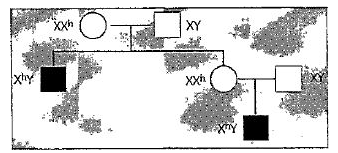A couple had a son who was haemophilic along with a normal daughter.
The daughter then grew older and was married to a man who was normal. They daughter had a haemophilic son.

Study the pedigree chart given above and find out the correct analysis-
The chart shows a sex-linked inheritance.
A criss-cross pattern is visible.
The female here is acting as the carrier of the disease.
(a), (b) and ( c) are correct.
The correct Answer is:D
The above pedigree chart shows a sex-linked inheritance. A criss-cross pattern is visible in which the parent passes the trait to the grand child. The female here is acting as the carrier of the disease.
Topper's Solved these Questions
- BOOK - EDUCART PUBLICATIONCHAPTER - SAMPLE PAPER 6EXERCISE - SECTION - C12videos
SAMPLE PAPER 6
- BOOK - EDUCART PUBLICATIONCHAPTER - SAMPLE PAPER 6EXERCISE - SECTION - C12videos
SAMPLE PAPER 6
- BOOK - EDUCART PUBLICATIONCHAPTER - SAMPLE PAPER 5EXERCISE - SECTION- C2videos
SAMPLE PAPER 5
- BOOK - EDUCART PUBLICATIONCHAPTER - SAMPLE PAPER 7EXERCISE - SECTION - C12videos
SAMPLE PAPER 7
Similar Questions
A cross between a normal couple resulted in a son who was haemophilic and a normal daughter. In course of time, when the daughter was married to a normal man, to their surprise, the grandson was also haemophilic.
a) Represent this cross in the form of pedigree chart. Give the genotypes of the daughter and her husband.
b) Write the conclusion you draw of the inheritance pattern of this disease.View SolutionA normal couple gives the birth to one haemophilic son and a normal daughter. Work out the cross to show the genotypes of parents and progeny.
View Solution
Knowledge Check
- Question 1 - Select One
Of a normal couple, half of sons are haemophilic and half the daughters are heterozygous. The gene for this disease in couple are located on
ABoth X-chromosomes of motherBY-chromosomes of fatherCOne X-chromosomes of motherDBoth sex chromosemes of the father - Question 2 - Select One
A woman has haemophilic brother and normal parents. She wants to marry a man who has no history of haemophila in his family. What is the possibility of her children having this disease
A50% of the sons may be haemophilicB50% of the total generation will be haemophilicCall will be haemophilicDnone of them will be haemophilic - Question 3 - Select One
A diseased man marries a normal woman and they get three daughters and five sons. All the daughters were diseased and sons were were normal. The gene of this disease is
ASex-linked dominantBSex-linked recessiveCSex-limited characterDAutosomal dominant
A diseased man marries a normal women. They have three daughters and five sons. All the daughters were diseased and sons were normal . The gene of this disease is
View SolutionA diseased man marries a normal woman. They get three daughter and five sons. All the daughters were diseased and sons were normal. The gene of this disease is?
View SolutionA diseased man marries a normal woman. The couple has 3 doughters and 5 sons. The daughters are diseased while the sones are normal . The gene of the disease is
View SolutionA diseased man marries a normal woman.They get three daughters and five sons were normal . The gene of this disease is :
View SolutionWhat are all the chances of colour blind daughter and sons being born in a marriage of normal man marrying a normal woman whose father was colour blind ?
View Solution

